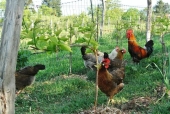












 1
1




































The ultimate goal of farming is not the growing of crops, but the cultivation and perfection of human beings. - Masanobu Fukuoka




 1
1




The beneficial yeast and friendly bacteria in the kefir culture consume most of the lactose (or milk sugar). Eat kefir on an empty stomach first thing in the morning before (or for) breakfast and you'll be delighted to find it can be easily digested -- as numerous people who have been lactose intolerant for years have discovered.
Yogurt contains transient beneficial bacteria that keep the digestive system clean and provide food for the friendly bacteria that reside there. But kefir can actually colonize the intestinal tract, a feat that yogurt cannot match.
Kefir contains several major strains of friendly bacteria not commonly found in yogurt, Lactobacillus Caucasus, Leuconostoc, Acetobacter species, and Streptococcus species.
It also contains beneficial yeasts, such as Saccharomyces kefir and Torula kefir, which dominate, control and eliminate destructive pathogenic yeasts in the body. They do so by penetrating the mucosal lining where unhealthy yeast and bacteria reside, forming a virtual SWAT team that housecleans and strengthens the intestines. Hence, the body becomes more efficient in resisting such pathogens as E. coli and intestinal parasites.
http://users.sa.chariot.net.au/~dna/kefirpage.html
I am lactose intolerant. Can I drink kefir? Kefir is ideal for people who like dairy products but are lactose intolerant. Commercial dairy products cause problems for people who are lactose intolerant. However, the probiotic bacteria in kefir grains metabolize the lactose during the culturing process, making the resulting kefir easier to digest. Kefir grains contain 18 species of Lactobacilli, as well as many other probiotics. These are described in the section "The Microflora And Growth-Cycle Of Kefir Grains" on Dom's kefir in-site. All together, there are over 40 species of probiotics and yeast. Hence kefir grains are much more efficient than yogurt culture, which contains only two probiotics (L. bulgaricus and S. thermophilus).


















 So good for you.
So good for you.








 1
1




The ultimate goal of farming is not the growing of crops, but the cultivation and perfection of human beings. - Masanobu Fukuoka

























 We're cool Kurt - I just 'posted back' so others reading wouldn't think they had to ferment milk for safety reasons or something. Just wanted to be completely clear. Fermenting has it's extra benefits, but it is NOT necessary....
We're cool Kurt - I just 'posted back' so others reading wouldn't think they had to ferment milk for safety reasons or something. Just wanted to be completely clear. Fermenting has it's extra benefits, but it is NOT necessary....







Wild Edible & Medicinal Plant classes, & DVDs
Live in peace, walk in beauty, love one another.








Charlie Michaels wrote:I really desire to supply as much of my own chicken feed as possible. Can someone who is good with chicken nutrition tell me if this will work? This is a suburban flock of 6-7. I want to eliminate store bought grain as much as possible from their diet.
Winter
Something like
30% Acorns
30% Jerusalems
5% Dried Greens for nutrition
5% Pickled foods
10% pumpkins
20% Supplemental Oats or Sunflower
______________________________________________________________
Spring
40% Fresh Greens (comfrey, lovage, fennel, nettle, you name it) and bugs
40% various wild tubers (thistle, burdock) or Jerusalems
10% kitchen scraps
10% Supplemental Oats or Sunflower
_______________________________________________________________
Summer
40% Greens and Bugs
40% Summer fruits from around the garden; goumi, peach, elderberry, grapes
10% Kitchen scraps
10% Supplemental Feed
_________________________________________________________________
Fall
10% Kitchen Scraps
20% Jerusalem Artichokes
20% Greens and Bugs
40% Fall fruits; apples, persimmons, quince, pawpaw
10% Supplemental Feed
Acorns foraged and then dried to preserve, then I'd throw them out periodically in winter. I'd like to feed them Jerusalem because I know I can grow alot of them and then store them in a root cellar.









|
Thank you my well lotioned goddess! Here, have my favorite tiny ad!
Support permies and give beautiful gifts to gardeners: permaculture playing cards.
https://gardener-gift.com/
|





